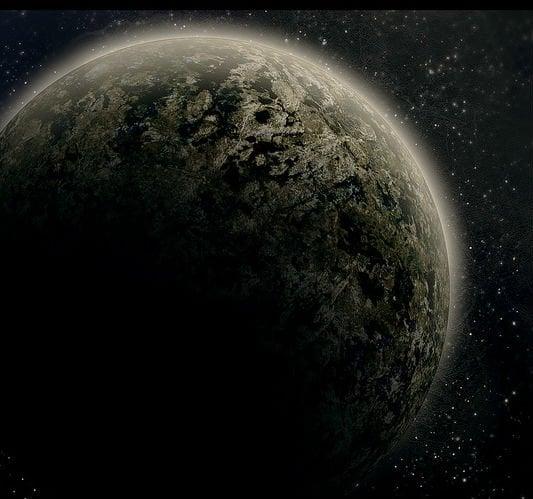Planet Obsidian
Created by Captain Corvus DeHavilland on 09 Aug 2020 @ 10:06pm
Planet
Obsidian is a planet in orbit of the star Loki, located near the Romulan Neutral Zone. It was given its name by Federation observers, due to its dark surface covered with black volcanic glass.
Obsidian's atmosphere, while class M, has a nearly non-existent ozone layer which, combined with the high radiation output of its star, makes Obsidian a harsh desert world. Still, numerous lifeforms survived there, including a sentient humanoid race.
Inhabitants
The people of Obsidian were distinguished by their dark-olive complexions, sharp features, and angular bodies. Two distinct cultures existed among the Obsidian people: the city dwellers, who took permanent refuge from the desert in the oasis settlement of Kalara; and the nomadic tribes who roamed the deserts and mountain ranges. The two groups maintained little contact, with the city dwellers considering the nomads uncivilized animals, and the nomads called the residents of Kalara "Tamed Ones", ignorant of the ways of desert life.One aspect of desert life was the concept of the Sunstorm Truce. During solar storms, all hostilities between tribes were put aside, and no person could be refused shelter from the sun's deadly output.
The people of Obsidian had very basic theological beliefs, with a personified force of Good: The Divine One, and an opposite force of Evil: the Fiery One, who is depicted with red hair and eyes of flame.
Cities
Kalara was the sole city on the planet Obsidian. As with many desert settlements on Earth and Vulcan, it was built of thick mud bricks with high windows, surrounding an oasis, and itself surrounded by a defensive wall. The city was ruled by a council and an executive leader; as of 2296, that leader was Sern Leshon.In 2296, a Starfleet outpost was built in Kalara.
History
Obsidian is rather unique amongst the planets within the United Federation of Planets. It’s one of a few Class L planets where a native civilisation has not only developed, but has advanced to the stage of developing into an industrial society. Obsidian was first discovered over 150 years ago during routine scientific surveys of the Federations outer borders. It was during this system survey that the native population made contact with the Federation requesting assistance to avoid a planetary disaster. Loki, the G-type star of the system had entered an active sequence several years before and was bathing the planet in constant solar radiation due to increased flare activity. The sustained solar flare activity had stripped the planet of its ozone layer, placing future generations of the natives at considerable risk. Although deemed unconventional by modern Federation historians, the decision was taken to offer Protectorate status to the planet to avoid the potential loss of life and civilisation. After careful negotiations a Federation science outpost was established in Kalara, Obsidian’s sole population centre.Throughout the late 2290’s and early 2300’s Obsidian was a flashpoint for many limited engagements between Starfleet and the Romulan Star Empire. This ranged from orbital demonstrations of force to planetary subterfuge and incitement of planetary unrest from a number of Romulan agents that had seeded themselves amongst the Kalaran’s and the nomadic tribes of Obsidian. Starfleet was eventually forced into establishing a more permanent presence on the planetary surface and established a second, larger outpost in the Taragi-shar Mountains in 2307.
After the self-imposed exile of the Romulans began in 2311, Starfleet began to work with the Kalaran population to reverse the increasing mortality rates amongst children due to the still-increasing solar flare activity from Loki. Federation scientists started working on a method to accelerate the natural restoration of the planet’s Ozone layer, although this project stalled on numerous occasions due to resistance from the nomadic tribes on Obsidian and resulting pressure from the Kalaran council not to interfere too much in the planetary development. Progress remains slow to this day, although the presence of Obsidian Command in geostationary orbit above Kalara has lessened the amount of radiation bombarding the main city due to the shielding employed by the starbase.
Planetary Geology
Being bombarded by solar radiation, Obsidian earned its name from the vast Obsidian “lakes” that are scattered across the surface. From orbit this gives the planet a uniquely stark appearance – being sandy in appearance interspersed with black glass. The planet shares a lot of characteristics with the many desert planets across the Federation – igneous heavy rock types, large sandy deserts, volcanic activity around the tectonic plates, little surface water. Networks of aquifers and supporting wells, and condensers are scattered across the surface providing water to the tribes and Kalara City itself. A handful of Oasis’s provide sanctuary from the harsher desert conditions on the rest of the planet, the largest series of which form the area around which the tribes who established Kalara settled.There are two large mountain ranges on the surface. The Rupathan Range, and Taragi-shar Range. The Taragi-shar Range is a heavy igneous rock mountain range dotted with numerous cave networks which provide shelter to the tribes during the harsh desert day and heavy solar activity. The natural protection from solar radiation also made it the natural choice for the larger Starfleet outpost established in the early 2300’s. The Rupathan range is hazardous to travel, provides the city with some protection from the sandstorms which are an unpleasant fact on the planetary surface.
Fog-Sand: Obsidian's version of quick-sand. Hard to spot, deep pools of ultra-fine, almost dust-like, sand that will not support the weight of a man. Qatarek are common in such places and creatures who stumbled in seldom survive, if the Qatarek did not kill them, they choked on the dust. Fog-Sand is dangerous for ships too, pilots landing on what they thought was hard packed sand, suddenly find their ship quickly sinking. The fine dust clogs intakes and engines, making take off nearly impossible if you are not quick enough to react.
Exerpts taken from Memory-Beta article on Planet Obsidian, for more details click this link
